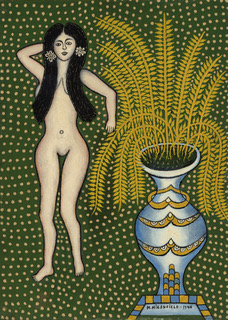‘Vernacular Women’ at Rico/Maresca Gallery
- Alessandro Berni

- Jan 29, 2020
- 2 min read
The women in Rico/Maresca Gallery’s exhibition ‘Vernacular Woman’ are not meant to be the ideal images of beauty. They are meant to be seen, sometimes as a reflection or through voyeurism. Created by those “on the margins” of the art world and unmarred by a traditional artistic discipline, the works in this visual anthology range over two centuries in multiple mediums— from paintings to sculptures to personal accessories.

Included in the exhibition are many interesting artists such as Renaldo Kuhler, Morris Hirshfield, and the ever-mysterious “Unknown Artist”. Tucked along the back wall in the meeting area, feeling almost forgotten, are four black and white self-portraits by Chicago’s Lee Godie. Each are captivating in their composure of Godie’s emotion. They feel almost accidental in their creation, but are anything but. I wish that these had been given a space more front and center to not only have the chance to be seen but also to more actively contrast the other works in the exhibition.
The other strong points of ‘Vernacular Women’ include Hirshfield’s two folk-like paintings. The use of colors and patterns as the background to contrast the subjects against immediately draw the eye of viewers entering the room. Helen Rae’s two untitled paintings also use a form of chaos in the background with which to offset and draw focus the women she portrays. Overall, though, the gallery feels understated, perhaps more than it should have been. Negative space left the work feeling dwarfed. The progress throughout the rooms felt uncertain, as it didn’t seem to follow time line or specific visual narrative at points. Mostly, with six works having unknown creators, it felt as though there had been a missed opportunity to reminisce on the quote by Virginia Woolf – “Anonymous was often a woman.”






Comments